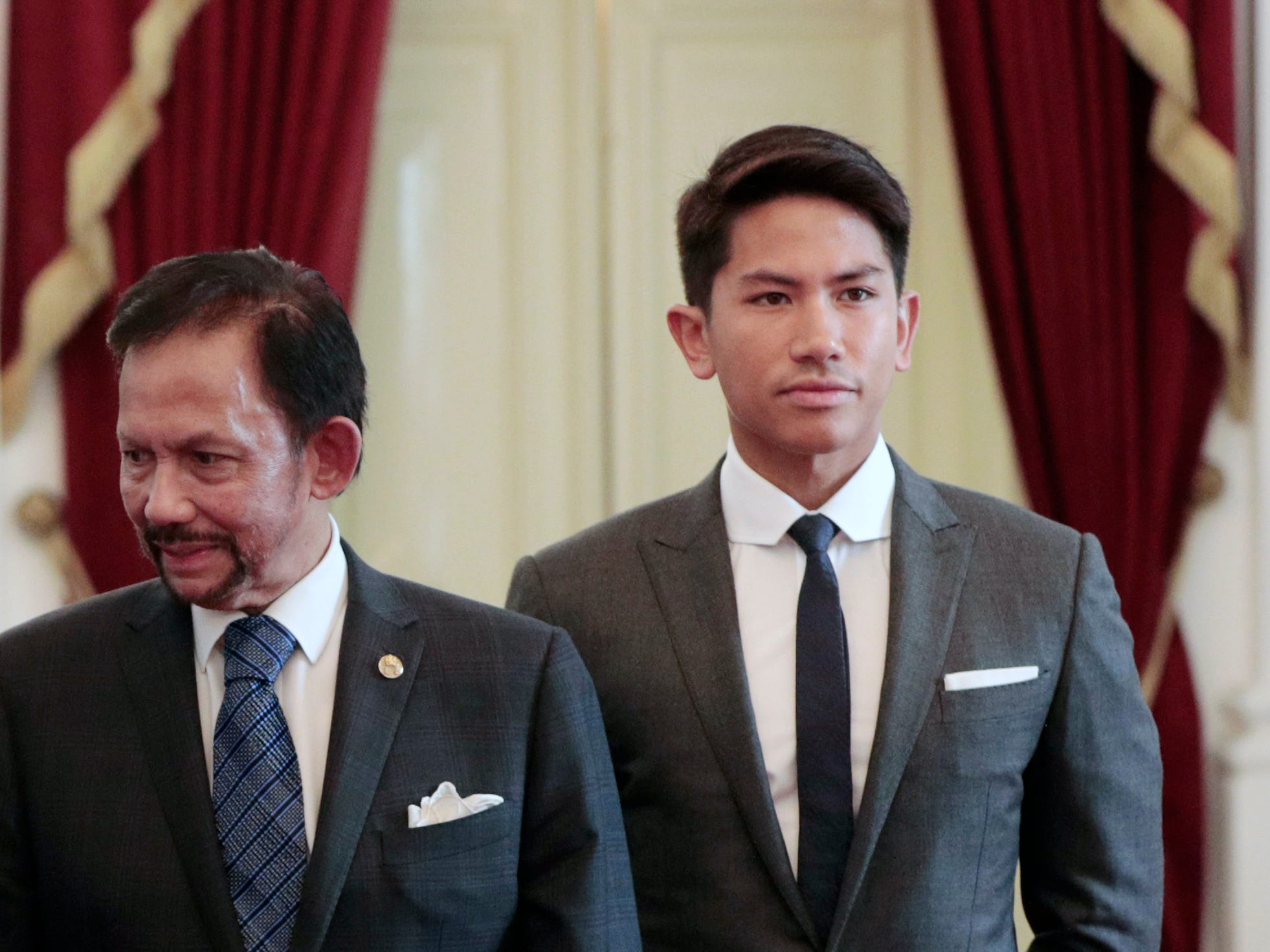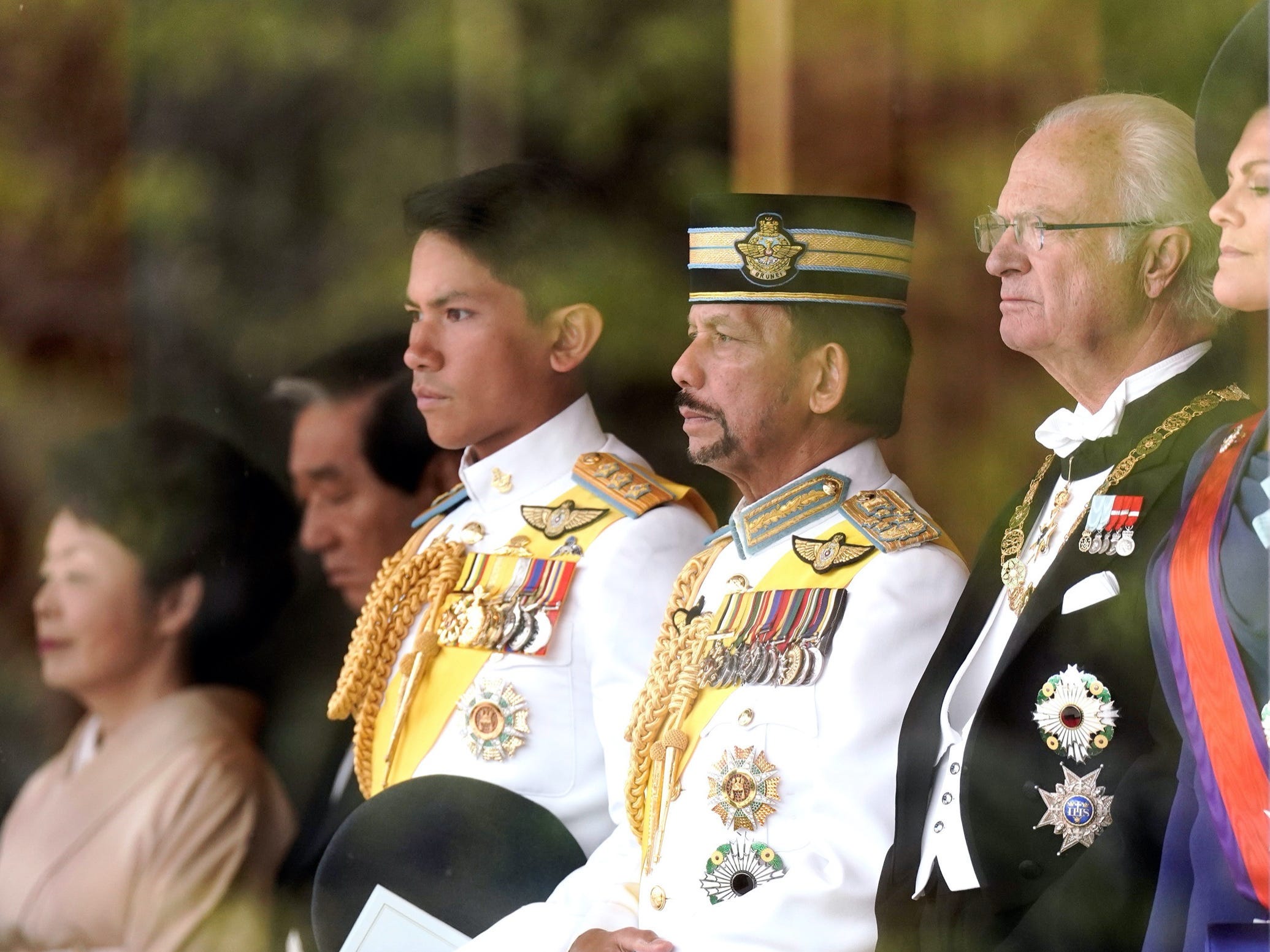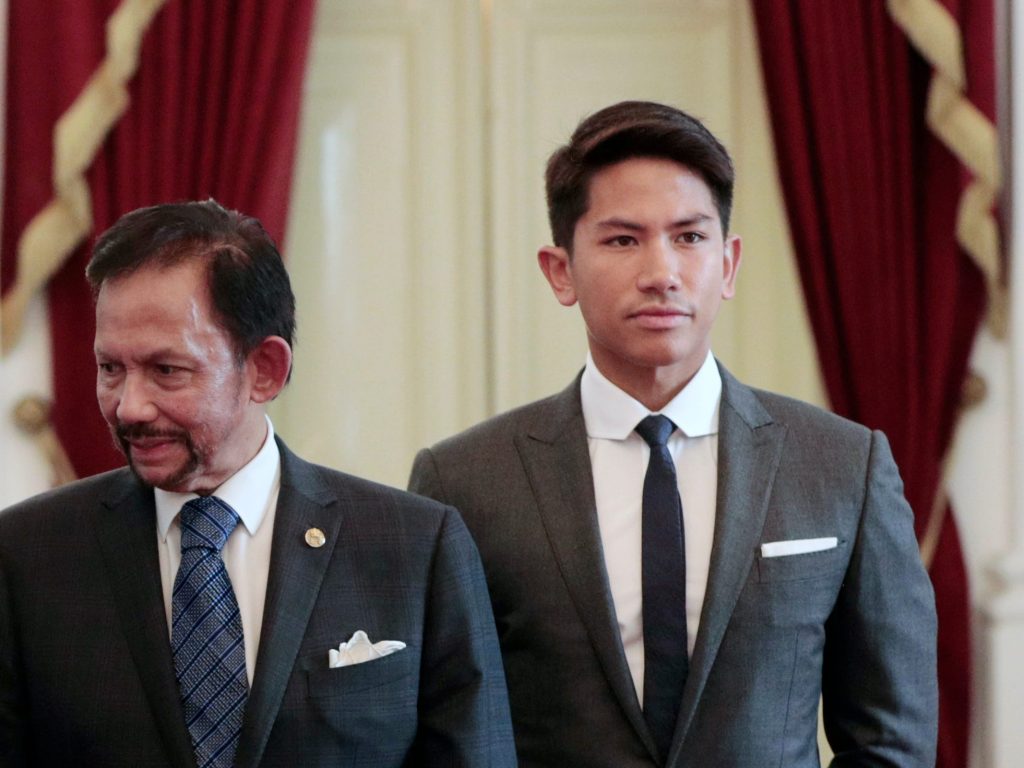
AP Photo/Dita Alangkara
- A handful of young royal men in Southeast Asia have amassed millions of Instagram followers.
- A prince of Brunei and two princes of Johor, Malaysia, grace their followers with post-workout selfies, yacht shots, and thirst traps.
- Experts say that unlike the British royals with their PR machine, the young royals appear to run their own Instagrams as personal accounts.
- Visit Insider's homepage for more stories.
He travels by private jet, does interviews with GQ, and shares shirtless post-workout Instagram photos that draw floods of heart-eye emojis from his 2.3 million followers.
But he's no actor or influencer. He's Prince Abdul Mateen, a 29-year-old royal of Brunei, a tiny yet prosperous nation in Southeast Asia where the monarchy still reigns supreme.
Prince Mateen is the 10th son of Sultan Hassanal Bolkiah, the ruler and Prime Minister of Brunei, whose 54-year rule makes him the longest-reigning monarch after Queen Elizabeth II. He is also one of a handful of millennial royal men in Southeast Asia who have cultivated Instagram followings on par with some of Hollywood's finest.
Prince Mateen's follower count is dwarfed by that of the crown prince of the Malaysian state of Johor, Tunku Ismail ibni Sultan Ibrahim, who has accrued an Instagram following of 3.5 million. His younger brother, Tunku Abdul Rahman, may have the smallest following of the three with just under 500,000 followers, but that still earns him influencer status as one of the top 0.94% of Instagram users, according to social media analytics firm Mention.
Like their headline-dominating British counterparts, the Southeast Asian princes are the faces of their respective countries. But unlike said counterparts, they seem to have unrestricted sign-off on their own social media posts.
Collectively, they're known for their thirst traps (for the uninitiated, a thirst trap is a shamelessly sexy social media photo), their expensive toys, and for gallivanting between infinity pools and beaches. But Insider spoke to social media experts and people who study Southeast Asia's society, who say the photos aren't just about getting likes. Instead, they're also critical to projecting and continuing the fantasy that royals are not only glamorous - they're also relatable.
"Social media gives this illusion," Mohd Faizal Musa, a visiting fellow at the ISEAS - Yusof Ishak Institute in Singapore, told Insider. "The royals might seem like they're stepping out from the luxurious life and talking directly to ordinary people." But, Musa says, "it's not real."
This facade of relatability may be more critical - not to mention subject to criticism - than ever in the pandemic era. Malaysia is facing political instability and surging COVID-19 cases. Many parts of the country are in their eighth week of strict COVID-19 lockdowns and some people have taken to flying white flags outside their homes as a sign that they're in desperate need of food or other essentials. While Brunei has been a COVID-19 success story with only 305 recorded cases and three deaths, the tiny country has faced international condemnation in recent years for its adoption of extreme interpretations of Islamic laws.
The royals did not respond to interview requests for this story.
Private jets, pet tigers, and thirst traps
The young Instagram royals of Southeast Asia lead lives of vast wealth.
"In Asia, if you get that rich, either you're part of an authoritarian regime or you're a royal," Musa said.
Prince Mateen of Brunei's father has an estimated fortune of up to $28 billion, and the family lives in the world's largest residential palace. The young prince's Instagram is filled with photos of him playing polo, hanging out in mansions, and cuddling with pet tigers.
And then there are his thirst traps.
Several scrolls into his Instagram feed, I started to detect the formula behind these photos: He's often shirtless, frequently lounging near an infinity pool, and has perfected a smoldering stare. The comments on these photos include marriage proposals and sometimes more explicit invitations.
He's landed on lists like "most eligible royal bachelors" and has inspired a "Prince Mateen Fan Club" Instagram account with nearly 40,000 followers. A similarly devoted TikTok fan account has almost 120,000 followers.
Prince Mateen's success on social media likely has a lot to do with the personal nature of his posts, said social media strategist Hou Yin Wan, country director at influencer marketing agency Gushcloud Malaysia.
"It's all about his experience in the army, how much he cares about that, and of course, he is a big player of polo," Wan said. "And of course he takes a lot of pride in his body, which I'm sure no one is really complaining."
That brings us to crown prince Tunku Ismail ibni Sultan Ibrahim of Johor, Malaysia. His thirst trap formula follows essentially the same one established by Prince Mateen, with the addition of an oft-pictured pensive stare, photos with David Beckham, and plenty of beach shots.
While they don't appear to do any of the typical sponcon found in popular Instagram accounts, these thirst trap princes do flaunt their favorite brands. TMJ - the nickname is an abbreviation of his royal title, Tunku Mahkota Johor - often posts photos of his sleek black Gulfstream, a private jet that retailed for $66.5 million when it launched in 2015. In one recent post, he sports a Rolex watch worth about $35,000, according to an Instagram account that identifies watches worn by celebrities.
Unlike Mateen, however, TMJ is no bachelor: He often posts selfies with his wife, Khaleeda Bustamam, who he married in 2014, and their children.
The final member of the royal Instagram trifecta is the crown prince of Johor's younger brother, 28-year-old Tunku Abdul Rahman Hassanal Jeffri. The fifth son of the Sultan of Johor has racked up nearly half a million followers.
Dubbed "Malaysia's Mercedes-racing prince" by the South China Morning Post, Tunku Abdul Rahman launched a Benz racing team in 2019. His Instagram feed is dominated by race car photos, with others sprinkled in that show him playing polo and hitting the gym.
Playing the part of royalty
In Malaysia, the royals are not technically involved in politics but still wield significant influence, Southeast Asia expert Michael Vatikiotis wrote in a 2015 Brookings report.
Every five years, one of the nine sultans that each rule a Malaysian state is rotated into the kingship.
In Brunei, one of the last remaining absolute monarchies in the world, the sultan is also the prime minister.
TMJ is poised to one day be Sultan of Johor. His younger brother Tunku Abdul Rahman and Brunei's Prince Mateen are of lesser royal stature, as several others are ahead of them in line to their respective thrones. However, they still enjoy the wealth and privileges of royalty.
As is common among royals, the three young men have also spent time in the military: TMJ was a captain in the Indian Army, Tunku Abdul Rahman has served in Malaysia's defense force. And Prince Mateen graduated from an elite military academy in the UK before becoming a lieutenant in the Brunei army.
Yet their actual royal responsibilities are likely fairly light, Vatikiotis said.

Kimimasa MAYAMA / POOL / AFP
"At the end of the day, it's not a really busy job," Vatikiotis said. "So much of it is ritual: cutting ribbons, conferring titles. There's a lot of golfing, sitting around in formal receptions, attending weddings, charities, and ensuring that the symbolism of the monarchy is maintained."
Unmonitored social media accounts fuel their popularity
The three young royals appear to offer an unfiltered and uncalculated look into their opulent lifestyles.
Meanwhile, their counterparts in the largely symbolic British monarchy present such a buttoned-up image on social media that the internet erupts on the rare occasions that Prince William and Kate Middleton are pictured holding hands.
Wan believes it would be a smart move for the Brunei and Johor royal families to put social media teams in charge of overseeing the princes' Instagrams, as they often comport themselves in ways that contradict the values of their subjects. But it's unclear whether they care enough to even consider such an intervention.
"In the case of the royal family of Brunei or royal family in Malaysia, I think they are not as sensitive and not as protective of this in comparison to the British royal family," Wan said. "Because if they were, they would already have it."
And anyway, some of these thirst trap princes descend from long lines of hedonistic royalty.
The Sultan of Brunei, for instance, had a reputation for throwing excessive, vice-filled parties and keeping harems of women throughout the '80s and '90s. And Prince Jefri Bolkiah, the sultan's brother, once famously owned a luxury yacht he dubbed "Tits," and two smaller boats known as "Nipple 1" and "Nipple 2."
"The sultan of Brunei and his brother Prince Jefri were known for their harems, their excesses in terms of purchasing of cars, their sexual exploits," Bridget Welsh, a Southeast Asia expert and associate professor of political science at John Cabot University, told CNN in 2019. "All of these women were coming into Brunei in the 1980s, so the image of them being the playboys was very prevalent."
In 2014, the sultan adopted a draconian version of Islamic Sharia law, which punished sodomy, adultery, and rape with death, including by stoning. When the new laws went into effect in 2019, the nonprofit organization Human Rights Watch said they pose "grave threats to fundamental human rights."
Critics suggested the sultan enacted the policy in order to contradict the less-than-pious image he and his family - including Prince Mateen - had cultivated.
For many, Mateen and the rest of the royal thirst traps represent a fundamental disconnect between the struggles of average citizens and the monarchies meant to inspire them - an extreme version of "do as I say, not as I do."
"There are a lot of people that are starving right now," Musa said of Malaysia. "Browsing these Instagrams and TikToks with lavish planes and cars, transportation, pets, sports like polo, it feels like the royals are not connected, that they're not helping."

